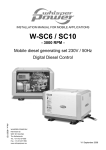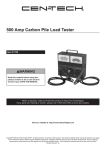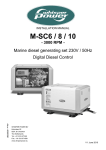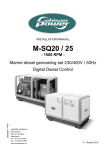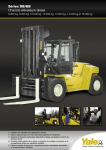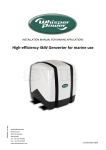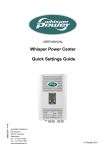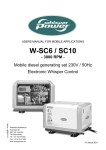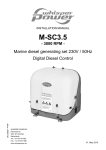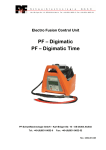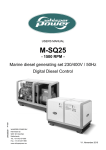Download Whisper Power W-SQ20 Installation manual
Transcript
INSTALLATION MANUAL FOR MOBILE APPLICATIONS W-SQ20 - 1500 RPM - Mobile diesel generating set 230/400V / 50Hz Digital Diesel Control Art.nr. 40200616 WHISPER POWER BV Kelvinlaan 82 9207 JB Drachten The Netherlands Tel.: +31-512-571550 Fax.: +31-512-571599 www.whisperpower.eu V1 April 2010 CONTENTS CONTENTS: 1 INTRODUCTION .............................................................................................................................................................. 3 1.1 General .............................................................................................................................................................. 3 1.2 Generating sets for vehicles ............................................................................................................................... 3 2 INSTALLATION ............................................................................................................................................................... 5 2.1 General .............................................................................................................................................................. 5 2.2 Location .............................................................................................................................................................. 5 2.3 Instructions for optimal sound and vibration insulation ....................................................................................... 6 2.3.1 Further recommendations ................................................................................................................. 6 2.4 Ventilation........................................................................................................................................................... 6 2.4.1 General.............................................................................................................................................. 6 2.5 Connections ....................................................................................................................................................... 7 2.5.1 Fuel supply ........................................................................................................................................ 8 2.5.2 Radiator cooling .............................................................................................................................. 10 2.5.3 Dry exhaust system ......................................................................................................................... 13 2.5.4 Electrical installation (12 Volt) ......................................................................................................... 15 2.5.5 AC power system (230 / 400 Volt) ................................................................................................... 17 3 INSTALLATION SPECIFICATIONS .............................................................................................................................. 19 3.1 General ............................................................................................................................................................ 19 3.2 Commissioning table ........................................................................................................................................ 19 3.3 Technical data .................................................................................................................................................. 20 3.4 Installation materials ......................................................................................................................................... 21 4 DIAGRAMS & DRAWINGS ........................................................................................................................................... 26 4.1 Layout generator control for W-SQ20 with 230VAC fan ................................................................................... 26 4.2 Terminal modes 115VAC – 230VAC - 400VAC 50Hz ...................................................................................... 27 4.3 Generator Diagram 3 phase with AVR 230V – 400V 50Hz with AVR............................................................... 28 4.4 AC Wiring Diagram single phase with AVR 230V Hz (Double Delta) ............................................................... 29 4.5 Electrical diagram radiator fan control 230VAC ................................................................................................ 30 4.6 Remote control panel drawings ........................................................................................................................ 31 4.7 W-SQ20 dimensions and footprint .................................................................................................................... 32 2 April 2010 / W-SQ20 for mobile applications / EN CONTENTS 1 INTRODUCTION 1.1 GENERAL This installation manual applies to the installation of the Whisper Power W-SQ20 generator set in vehicles. This manual is valid for the following models: Part number 41101320 41101326 Description W-SQ20 230V/400V 1500rpm Mobile W-SQ20 230V/400V 1500rpm Mobile -ungrounded For other models see our website: www.whisperpower.eu. WARNING A warning symbol draws attention to special warnings, instructions or procedures which, if not strictly observed, may result in damage or destruction of equipment, severe personal injury or loss of life. DANGER This danger symbol refers to electric danger and draws attention to special warnings, instructions or procedures which, if not strictly observed, may result in electrical shock which will result in severe personal injury or loss of life. 1.2 GENERATING SETS FOR VEHICLES Whisper Generators originate from the marine sector. But there are also specially designed Whispers available for mobile applications, suitable for supplying power on board of vehicles to use professional apparatus and equipment, strong lightning and air conditioning etc. The cooling system and exhaust system on vehicles is completely different from standard marine systems. On vehicles the engine of the W-SQ20 is cooled by a radiator with an electric (230V or 3x400V) driven fan. Note that the alternator of the W-SQ20 is cooled by air. The radiator of the engine can be fitted below, on top or in the side of the vehicle. The exhaust is of the dry type and includes a stainless flexible bellow and high quality mufflers. Never use rubber exhaust hose, neither fiberglass nor plastic exhaust parts in a dry exhaust system as applied on vehicles. Unless indicated otherwise. WARNING! Before working (installation) on the system read the section safety instructions in the user’s manual Figure 1: Typical vehicle application radiator side mounted EN/ W-SQ20 for mobile applications / April 2010 3 INTRODUCTION Figure 2: Typical vehicle application radiator top mounted 4 Figure 3: Typical vehicle application radiator bottom mounted April 2010 / W-SQ20 for mobile applications / EN INSTALLATION 2 INSTALLATION Figure 4: Schematic installation diagram 2.1 GENERAL To ensure reliability and durability of the equipment, it is very important that the installation is carried out with the utmost care and attention. To avoid problems, such as temperature problems, noise levels, vibration, etc. the instructions set out in this manual must be followed and all installation work must be carried out professionally. 2.2 LOCATION When looking for a proper place for a generator in a vehicle all relevant aspects have to be taken into account • Accessibility • Solid foundation • Space to mount the radiators (Refer to par. 2.5.2) • Space to mount the exhaust (Refer to par. 2.5.3) • A way to fit the fuel lines Since Whisper generating sets have extremely compact dimensions, they can be installed in tight locations. Please consider that even almost maintenance-free machinery must still remain accessible. When selecting the location area in which to mount the generating set, make sure there is sufficient room to carry out any maintenance work. The unit must be easily accessible on the service side and on the distribution side to have access to the V-belt. All models can be serviced from one side. Note that oil filling can be only done on the top side of the engine. Cooling liquid can be filled via the expansion tank. The top of the engine (rocker cover) has to be accessible for adjustment of the valve clearance. Please also note that in spite of the automatic oil pressure sensor it is still essential that the oil level is checked regularly. EN/ W-SQ20 for mobile applications / April 2010 5 INSTALLATION 2.3 INSTRUCTIONS FOR OPTIMAL SOUND AND VIBRATION INSULATION Position the generating set as low as possible in the vehicle. The generating set is already secured to the base frame by means of flexible engine mountings. The base frame is mounted to the chassis of the vehicle on a second set of rubber mountings that is included in the delivery. Use the included mounting template to determine the mounting spots. When it is possible to mount the unit directly on the chassis of the vehicle this has advantages in preventing vibrations by resonance. 2.3.1 Further recommendations Whisper generating sets are standard equipped with a sound cover. This sound cover has been designed to give effective sound insulation. For optimum sound and vibration dampening, the following factors should be considered. 1 Most important is the structure on which the generator is placed to be stiff. Directly below the rubber mountings the structure should be supported vertically to the chassis of the vehicle. 2 In larger vehicles a separate and insulated space for the generator will help to damp the noise even further 3 Avoid mounting the generating set in close proximity to thin walls or floors that may cause resonance. 4 Sound dampening is extremely poor if the generating set is mounted on a light weight flimsy surface such as plywood which will only amplify vibrations. If mounting on a thinner surface cannot be avoided, this should be at least be reinforced with stiffening struts or ribbing. If possible, holes should be drilled or cut through the surface to help reduce the resonance. Covering the surrounding walls and floors with a heavy coating plus foam will certainly improve the situation. 5 Never connect the base of the generating set directly to walls or tanks. Figure 5: Mounting of the Whisper generating set. 6 2.4 2.4.1 VENTILATION General The generating set normally draws air from the engine compartment. Engine compartments with natural ventilation must have vent openings of adequate size and location to enable the generating set to operate without overheating. To allow an ample supply of air within the temperature limits of the generating set an opening of at 2 least a half square meter (0,5 m ) is required. A "sealed" engine compartment must have a good extraction ventilator to maintain reasonable ambient temperatures. High temperature of intake air reduces engine performance and increases engine coolant temperatures. Air temperatures above 25°C reduce the engine power by 2% for each 5°C of rise. To minimise these effects the engine room temperature must not be more than 15ºC above the outside ambient air temperature. Apply a combination of ventilators, blowers and air intake ducting to meet the temperature limit. The air inlet ducts should run to the bottom of the engine compartment to clear fumes from the bilge and to circulate fresh air. Air outlets should be at the top of the engine compartment to remove the hottest air. An engine compartment blower should be used as an extraction ventilator to remove air from the engine room. In cases where it is impossible to meet the above mentioned temperature limit by using engine compartment ventilation, connections are to be made for an air inlet directly to the generator enclosure. With these connections the generating set can be directly connected to an air duct. Air inlets should be louvered, where appropriate, to protect the engine room and to protect the generating set from rain and water spray. X = wrong, V = OK April 2010 / W-SQ20 for mobile applications / EN INSTALLATION 2.5 CONNECTIONS The generating set comes with all supply lines and output cables (i.e. electric cables, coolant connections, exhaust, fuel lines etc.) already connected to the engine and generator. The supply lines are fed through the capsule’s front base. The connections are marked as shown in figures 7 till 10. All electrical connections, cable types and sizes must comply with the appropriate national regulations. Supplied cables are rated for ambient temperatures up to 70°C. If the cables are required to meet higher temperature requirements, they must be run through conduits. ATTENTION! Before working (installation) on the system read the section safety instructions Figure 6: Mounting of the air strainer element 05 Exhaust connection 2” 09 Fuel out Ø8mm 06 Coolant Engine OUT Ø35mm 10 Fuel in Ø8mm 07 Battery positive (+) 35mm2 11 Coolant Engine IN Ø35mm 08 Battery negative (–) 35mm2 Figure 7: Connections of the W-SQ20 for mobile applications: EN/ W-SQ20 for mobile applications / April 2010 7 INSTALLATION 2.5.1 Fuel supply 1 FUEL TANK Fuel tanks should be made of appropriate material such as (stainless) steel or plastic. Steel tanks should not be galvanised or painted inside. Condensation can occur in metal tanks when temperature changes. Therefore, water accumulates at the bottom of the tank and provisions should be made for the drainage of this water. The tank will need a filling connection, a return connection and an air ventilation connection which will require protection against water entry. Some official regulations do not allow connection points at the base of the fuel tank; connections are to be made at the top of the tank with internal tubing down to a few cm above the bottom of the tank. Using the existing fuel tank of the car-engine the fitting should be carried out with extra care. Both a supply line and a return line should be installed and go into the tank from the top. Interference of the two systems (car engine and generator engine) should be avoided. Do NOT connect the fuel lines to the lines of the vehicles engine fuel supply. Driving the tank empty below the level of the suction pipe of the generator could make it necessary to bleed the fuel system. 2 FUEL LIFT PUMP The generating set itself is equipped with a fuel lift pump; therefore the tank can be installed at a lower level than the generating set. See figure 8. The maximum suction height is 1 m. The W-SQ20 has a mechanical fuel lift pump that should be primed manually when the first time used. If the pump has to lift the fuel higher than one meter an external fuel lift pump must be installed. (Art. No. 50201060) The control board is already prepared to connect an extra fuel pump. When using a second electric fuel supply pump, it is recommended to mount a loose supplied pump close to the tank and mount it in an angle or vertical to prevent air bubbles to block the system. The pump will become quite hot and should be mounted out of touch. (Refer to figure 9) The pump makes clicking noises and therefore could be mounted on rubber mountings. When the clicking noises of the pump are not acceptable an other noiseless pump is available as an option. (Art. No. 50202200) Figure 7 Fuel supply (fuel tank is above the generating set) 1 Fuel return 2 Fuel supply 3 Prefilter / Water separator (optional) 5 Fuel Tank 8 April 2010 / W-SQ20 for mobile applications / EN INSTALLATION 1 2 5 A 3 4 Figure 8 Fuel supply (fuel tank is below the generating set) 1 Fuel return 2 Fuel supply 3 Prefilter / Water separator (optional) 4 Extra fuel lift pump (optional) 5 Fuel tank Figure 9: Fuel line assembly with vertical mounted additional pump and fuel lift pump mounted in an angle EN/ W-SQ20 for mobile applications / April 2010 9 INSTALLATION 3 FUEL PIPES When the tank is above the generating set (figure 7) we recommend ending the return line on the top of the tank. When the return is on the top - in case of a leakage the return line cannot overflow because of siphoning. One will only need a fuel cock in the fuel supply line. When the tank is below the generating set we recommend ending the return line on the bottom of the tank (A) below the inlet of the supply line. Both supply and return fuel pipe lines should be appropriate material and 8 mm outer diameter tubing. The quality of the tubing of fuel pipes could be submitted to local regulations depending on the application of the vehicle. The fuel pipes can be plumbed to the flexible hoses which are on the generating set and have a connection to fit to 8 mm pipe. This fuel lines fulfils CE standards and are according to ISO 7840 A2. It is important to avoid bends in the pipes, as they could trap air bubbles. The return pipe should never be connected to the suction pipe. The return pipe should never be connected to the suction pipe. The return line should be of 8 mm diameter and go straight back via the top to the bottom of the tank. When the return is too narrow, has too many bents and goes back to the bottom of the fuel tank, the back-pressure could be too high. This results in irregular running of the engine. When the engine runs irregular, one can check if back-pressure is the problem by disconnecting the return line just outside the canopy and draining it in a canister. When the engine runs smooth now, the return piping has to be changed. It could also help to install a second (electrical 12V) fuel lift pump in the supply line to increase the pressure. 2.5.2 Radiator cooling 1 GENERAL INSTRUCTIONS The radiator can be mounted below the floor, in the side or on the roof of the vehicle. Wherever the radiator is mounted the well functioning of the system depends on the well circulation of the coolant. A roof mounted radiator brings the most risk for circulation problems, because air trapped in the radiator or a low level of the coolant, will immediately affect the cooling capacity of the radiator. It is recommended to keep the radiator as close as possible to the engine. The piping should be fitted as direct as possible. When the radiator is above the engine, the piping should be fitted below the top of the radiator! (refer to figure 10). Bents in the piping, that can trap air bubbles, should be avoided or ventilated (refer to figure 11) Piping should not be fitted above the radiator! OK 4 FUEL FILTERS A fine fuel filter is installed which requires maintenance. Whisper Power advises to install an extra fuel filter/ water fuel separator near the fuel tank. Before starting your generating set for the first time follow the fuel system bleeding procedure in the users manual. Figure 10: Air traps should be avoided Figure 11: Ventilating an air trap 10 April 2010 / W-SQ20 for mobile applications / EN INSTALLATION Special attention should be paid to the ventilation of the system. Each installation system is standard supplied with an expansion tank for the coolant, which is also used to release air bubbles and makes it possible to add coolant into the system in an easy way. This expansion tank should be at the highest point of the system and mounted as high as possible. The expansion tank must be fitted in the outlet of the radiator = the inlet pipe of the engine side mount Most cooling problems originate from air traps blocking the circulation of the engine coolant. A For the engine we use a pressurised system. The 12 mm connection on the top is closed. Wherever the radiator is mounted it is necessary to ventilate the exhaust manifold of the engine. The exhaust manifold has an 8 mm connection to ventilate the manifold. There is an 8 mm high pressure and high temperature resistant hose in the delivery to connect the hose connection on the side of the manifold with the expansion tank. (refer to figure 6). Initially the engine cooling system can be filled via the cap on the exhaust manifold of the engine. However when the radiator is above the engine one can only fill the system to the level of the manifold. Additional filling has to be done via the expansion tank. For large engine cooling systems with long pipes or for extra reserve there is an extra large expansion tank with a content of 7 litres and an alarm for low coolant level that can be supplied as an option (refer to figure 12). bottom mount Figure 13. Outgoing connection connected to the expansion tank When both radiators are flat mounted on the roof, the expansion tanks should be mounted a little higher. (refer to figure 14 detail B). top mount Figure 12: 7 litres optional expansion tank with low level alarm. When mounting the radiator it is important to take care that the outgoing connection, which is the connection to the engine inlet, is on the top position (refer to figure 13 detail A) and is connected to the expansion tank. Also when the radiator is mounted flat at the bottom of the vehicle the outgoing connection is connected to the expansion tank This is the best way to have the system release air and to add liquid when necessary. EN/ W-SQ20 for mobile applications / April 2010 B Figure 14: Low profile radiator assembly on the roof Most cooling problems originate from air traps blocking the circulation of the engine coolant. 11 INSTALLATION It is very important to use good quality heat resistant hose and fittings. Therefore it is strongly advised to use Whisper Power installation kits. 2 HOW AND WHERE TO MOUNT THE RADIATOR The radiator kit includes rubber mountings to prevent vibrations to be transferred to the body of the vehicle (figure 15). Due to the difference between vehicles general instructions are not available. One has to find out where the best place for mounting is. For OEM customers Whisper Power can supply a special customised installation kit. Figure 17. Making use of the space below the floor to get an optimal flow of air through the radiators. Side mounted radiators Figure 15. Radiator on rubber mountings Bottom mounted radiators When bottom mounted the radiator should not be the lowest point of the vehicle to avoid damage. A free flow of air should be guaranteed. When horizontal mounted, the fan should be on top, which causes a flow of air downwards. Often it is possible to find a place where extra space above the fan helps to create a free flow of air. It is recommended to make a shield below the radiator to catch stones and dirt and operates as a spoiler. The distance between the radiator and the shield should be at least 50 mm. Sometimes it is possible to build the radiators and shield on a sub frame that is mounted below the vehicle as a module. Most effective and easy is to mount the radiator in the side of the vehicle, if possible below the level of the top of the engine. A louvered grid should protect the radiator from rain and objects, but must not block the airflow. The fan should be inwards which causes the air to blow outwards. A disadvantage of having the radiator in the side is possibly more noise of the electric fan and a flow of air that could be felt by people passing by. A free flow of air should be guaranteed. The ventilation connection of the cooling system that goes to the expansion tank, should be in the outgoing coolant flow on top of the radiator. air flow Measures have to be taken to prevent the hot air circulating and reducing the capacity of the radiators. Refer to figure 16 side mounted Figure 18: Side mounted radiator Figure 16: Bottom mounted radiators with shield 12 April 2010 / W-SQ20 for mobile applications / EN INSTALLATION Roof mounted radiators 2.5.3 The radiator on the roof is often the best option from the point of view of keeping the noise of the fans away from people and it will give the best result in dissipating the heat. However, often this option conflicts with the possible need to keep the vehicle as low as possible. An other disadvantage is that the piping has to go through the roof which requires provisions to be waterproof. Also negative is that a roof mounted radiator is more sensitive for air traps (see figure 10). When having enough space it would be ideal to have the radiator vertically mounted on the roof. Note that the expansion tank should be above the radiator. When having the radiator horizontally mounted on the roof (refer to figure 19) enough space (50 mm) should be between the roof and the radiator fan to have a free flow of air. When the radiator is roof mounted there should be protection against weather conditions. To avoid damage while the vehicle is driving at high speed, the use of a spoiler could be necessary. 1 GENERAL REMARKS A dry exhaust muffler system should be very effective in silencing the exhaust when applying the right mufflers. However noise could be generated by vibrations in the mufflers and be transferred to the chassis. Tacit factors like the length of specific pipe sections could cause the noise to be amplified. It is very difficult to take these factors into account. horizontal vertical Figure 19: Two examples of a top mount radiator 3 TWO SPEEDS FAN (OPTIONAL) To keep the noise as low as possible the fan of the radiator can run at two different speeds. As option a control box is available which can be used to drive the fan with two speeds, depending on the load of the generator. In normal mode the electric motor of the fan is powered by a low voltage and runs at low speed. This is achieved by means of a transformer. In this mode the fan almost produces no noise. Only when necessary - this is controlled by thermostat switches - the fan is switched to a higher voltage and will blow at full speed (refer to the connection diagrams in paragraph 4.5). Dry exhaust system Figure 20: Dry exhaust systems on vehicles The standard Whisper Power exhaust kit contains the materials to perform a professional installation. In the kit is a stainless steel flexible bellow (hose) to allow for expansion and to prevent vibrations to be transferred. Rubbers are supplied to mount the mufflers flexible. The insulation blanket for the flexible bellow and the resonance muffler are also very effective in damping vibrations. Still it could be that additional measures has to be taken like an extra clamp in a vibrating section of pipe, insulation blankets on other parts of the system and possibly even additional mufflers. When the exhaust is led through the roof of a vehicle, measures has to be taken to prevent rainwater to enter the system. Special rain caps are available as an option. However, when not strictly necessary, we recommend using the standard fan control instead of the two speeds fan control, in order to keep the system as simple as possible. Figure 21. Ways to prevent water to get in EN/ W-SQ20 for mobile applications / April 2010 13 INSTALLATION A negative feature of a dry exhaust system is the heat radiated by its components. Measures are taken to overcome the heat problem: The exhaust bent to bring the exhaust out of the canopy is cooled by water. Insulation blankets are included in the exhaust kit to insulate the flexible bellow and the first muffler. When a dry exhaust has its outlet on the roof, all the pipes inside the vehicle has to be insulated. The exhaust pipes will be very hot and all accessible pipes and mufflers are dangerous to people when not insulated. There are companies that are specialised in insulating hot pipes and fancy systems are available to make it good looking. However it is also possible to do it yourself by winding fibreglass or Rockwool around the pipes and seal it with aluminium tape. 2 THE STANDARD DRY EXHAUST SYSTEM The standard exhaust system contains: On the generator set: • An insulated exhaust bent In the exhaust installation kit: • A stainless steel shielded flexible bellow. • One resonance muffler • One absorption muffler • Clamps and rubbers to mount the system flexible • Fittings, bents and pipes to make the different connections • Blankets for thermal and sound insulation. The mufflers are high quality industrial mufflers that are much more effective, robust and durable than mufflers made for automotive use. 3 INSTALLATION OF THE EXHAUST Before determining the location of the generator set one has to consider how to get away with the exhaust. Often one can find space below the vehicle between the chassis to mount the mufflers. The outlet should blow the fumes away from the doors to avoid a nasty smell. When the gasses are in the flow of air blowing from the radiators this will help to avoid the fumes to be noticed. Under no condition the fumes should be sucked into the flow of air into the radiators. In wind still conditions a light smell of exhaust fumes around the vehicle will not be avoidable. To bring the exhaust to the top of the vehicle gives the best results on noise and smell. However, when the pipes go through the vehicle they should be insulated and around the hole in the roof should be a collar to prevent rainwater to leak in. Both mufflers could be on the roof or one of them or both could be below the vehicle. In general it is better to have the mufflers wide apart: the resonance muffler close to the generator and the absorption muffler on the end of the line. A short pipe (30cm) should be on the far end after the absorption muffler. The absorption muffler has no flow direction and could be mounted both ways. The resonance muffler should be mounted according to the indication on the muffler itself. The resonance muffler should be fitted according to direction of the gas flow indicated. In the kit are clamps to mount the exhaust pipes to stainless steel bars. These bars should be mounted to the chassis of the vehicle. It is recommend to use rubber mountings whenever possible. However take care that the heat conducted through the brackets will not affect the rubber. Refer to figure 22 how to mount the rubber in a safe way. When any doubt an extra safe guard could be constructed from steel wire or chain. Figure 22: Mounting bracket in rubber with safe guard 14 April 2010 / W-SQ20 for mobile applications / EN INSTALLATION 2.5.4 Electrical installation (12 Volt) 1 DIGITAL DIESEL CONTROL SYSTEM The electrical control system is standard in 12 Volt with negative earth. Non- earth return is available as an option. All electrical wiring has been prepared on the generating set to the control panel prior to despatch from the factory. The engine is controlled by a very advanced microprocessor based system: Digital Diesel Control. The “black box” containing the microprocessor is located on top of the alternator. A local control panel is on the generating set. Remote control A remote control panel also containing a microprocessor is in the delivery. A 15 m intermediate 8-pole communication cable is in the standard supply as well (refer to figure 23). If necessary an optional longer (up to 30m / 100ft) intermediate cable can be connected if the standard length does not suit the required distance. When a longer distance than 30m / 100ft is required, consult the Whisper Power service department for advice. One can mount the control panel after drilling a hole in the dashboard using the plastic cover. Refer to the dimensional drawings in chapter 4. The panel without the plastic cover fits the Mastervision modular panel system. More remote control panels (slave panels) can be put in parallel by using the modular connectors on the back of the units. As a slave one can use the same panel offering all functions again. It is also possible to use an old or new type slave panel only to start and stop the generator. Old type remote panels and system panels can be connected by means of the green connector. When using the factory settings, installation is very simple: just plug the remote cable into the remote and the generator is ready to use. Refer to figure 24. REMOTE CABLE REMOTE CABLE 12 11 10 9 8 7 J3 6 5 4 3 2 1 WIRING COLOURS 1 2 3 4 5 6 7 8 9 RED GREEN BROWN YELLOW PINK PURPLE BLUE WHITE RED/BLUE 10 11 12 GREY/PINK GREY BLACK SENSE BAT. 2 WRP/2 WARNING RELAY MAX. 150 mA Whisper Remote Panel Figure 24 Remote box terminals Acoustic alarm or warning lamp One can connect an external max.150 mA relay to generate an acoustic warning or applying a warning lamp etc. Be aware of polarity as some relays has a diode inside and should be connected plus to plus en minus to minus as indicated. Refer to figure. 24. Connection for emergency stop / fire alarm switch Figure 23 Remote control cable EN/ W-SQ20 for mobile applications / April 2010 To connect an emergency stop button or to stop the generator automatically in case of a fire alarm, you can use the bypass connection between fastons J7 and J18 on the backside of the local control panel. See figure 25. To do so, remove this bypass connection and then replace it 15 INSTALLATION by an emergency switch or a potential free fire alarm switch with normally closed contacts Remove bypass between J7 - J18 local control panel (rear view) Normal operation Alarm / emergency Fig. 25: Connection for emergency stop / fire alarm switch Automatic starting and stopping Automatic start/stop Whisper Power cannot be held responsible for damage caused by the unattended running generator using the autostart/stop mode or interval mode. Using the auto-start/stop (interval) mode the generator can start unexpectedly. When working on the electrical system, the 3 Amp fuse must be removed from the control panel and the battery plus cable must be removed from the battery. The Whisper Power Digital Diesel Control system offers several options for automatic starting and stopping. Access to this menu and other menus could be blocked. For de-blocking and setting up this options refer to the APPENDIX of the DDC user’s manual. One of these options is to monitor a second battery (not being the starter battery) to start the generator automatically when the voltage of this battery drops below a certain setting. Other names for this second battery are “auxiliary battery”, “service battery”, ”users battery” or “consumers battery”. We will refer to this battery as “the second battery”(BAT2). In some menus the starter battery could be indicated as “the first battery” (BAT1). A sense wire to monitor the second battery should be connected (attention polarity!) to the connector on the back of the remote panel. Refer to figure 24. The sense 16 wires must be connected directly on the second battery before a main switch and be protected by a 3 Amps fuse. (Monitoring the generator starter battery does not require an extra sense connection) Settings When one want to apply other settings than the factory settings refer to the DDC users manual, especially to the APPENDIX. 2 STARTER BATTERY For starting, the Whisper generator set requires a 12V starter battery with the following capacity: Model W-SQ20 Minimum capacity 120Ah The generating set can be connected with the main engine battery or have its own battery. We strongly recommend the use of a separate battery for the generating set and to keep the wiring system for the vehicle engine and the domestic DC supply system completely separate and individually connected to separate batteries. 230VAC IVO 12/10 A B + 12V - Figure 26 Starter battery However, the negative of all the batteries on the vehicle should be interconnected to avoid difference in the voltage level of the earth on different places causing trouble to electronic devices which might be in the system. The above recommendation is not valid for vehicles having the starter battery of the vehicle engine or other auxiliary equipment positive grounded. When this is the case an expert should be consulted. A battery switch may be used to interrupt the positive connection. The starter battery is charged by the alternator on the engine. An additional battery charger will help to keep the battery in good condition when the generating set is not used. A battery charger is not included in the standard supply. A high efficiency battery charging unit can be ordered from Whisper Power which is able to charge both the vehicles’s main battery and the starter battery. Also a small charger can be used to charge the starter battery only, such as the April 2010 / W-SQ20 for mobile applications / EN INSTALLATION IVO SMART 12/10. A battery switch and a charger are included in the battery installation kits, art. no. 40230220 (160Ah) 3 OTHER RECOMMENDATIONS AND WARNINGS The battery should be secured for poor road conditions and the terminals should be insulated. For extra safety the battery can be enclosed in a wooden, plastic, fiberglas etc. (non metal) box. Even when the earth return system is applied a negative battery cable should be used and the vehicle should not to be used as a conductor. The battery cables are supplied in a standard length of 1.5 m, if longer cables are required a larger cross sectional area should be considered to compensate for voltage reduction. When two batteries are used in series to provide a 24 Volt supply system, never take off 12 Volt (starting) power from one of these batteries. This will result in severe damage to both batteries within a short time. Disconnect the battery leads if electrical welding is to be carried out, otherwise damage will be caused to the diodes of the alternator. As explosive hydrogen gases may be discharged during charging, the battery should be located in a well ventilated room. Ensure that the supplied battery cable connectors are properly fitted and never remove during or shortly after charging as sparking can occur, which may ignite the hydrogen gasses. 2.5.5 AC power system (230 / 400 Volt) The electric power supplied by the generator is of a high voltage and dangerous to people. Before working (installation) on the system read the sections on safety in the users manual. Realise hat people are not used to have 230/400 Volt available on a vehicle. Put warning signs on wall sockets and on junction boxes. Instruct non-regular users of the vehicle. Warn maintenance personal of garages that do service on the vehicle. Generators used on vehicles that are operated in a hazardous environment have often to fulfill special regulations and additional measures have to be taken accordingly. Be sure that all electrical installations (including all safety systems) comply with all required regulations of the local authorities. All electrical safety/shutdown and circuit breaking systems have to be installed onboard as the generating set itself cannot be equipped with such equipment for every possible variation. The vehicle’s power supply system should be suitable and safe for the AC voltage which is applied and the power that will be generated. Special attention has to be paid on dividing the system in branches which are fused individually. It is absolutely essential that each and every circuit in the electrical system is properly installed by a qualified electrician. The W-SQ20 can be connected as a single phase 230 Volt generator by an arrangement of the wiring in double DELTA. When the wires are arranged in STAR the output will be 230/400Volt. Connected as a three phase 230/400 Volt generator, 3x 400 Volt is available between the phases. At the same time 230 Volt is available between every phase and neutral. When applying 3 phases the installation should be laid out in such a way that there is a reasonable balance of load between the three phases. To avoid problems with unbalanced loads one could apply a 400V 3 phase to 230 Volt single phase transformer. EN/ W-SQ20 for mobile applications / April 2010 17 INSTALLATION 1 FUSE An output fuse (between the generating set and the electrical installation) should be installed to protect the installed electrical system. For the W-SQ20 the maximum single phase current at 230V is 108 Amps. Using three phases the fuses should be three times 36 Amps and mechanically connected. The fuses must be of the slow reacting type. For electrical motors connected to the system, a motor protection switch must be installed 2 GROUNDING The AC alternator windings are not grounded. The housing of the alternator and all other metal parts are grounded To make a connection between “neutral” and “ground” is necessary as part of a specific insulation failure protection system. It is possible that the electric installation in the vehicle must be protected against insulation failures. Methods of protection are subjected to rules that can be different depending on the use of the vehicle and local standards. Experts in this field should be consulted 18 3 CABLE For the power cable we recommend the use of 3 wire single phase or 5 wire tri-phase oil resistant cable with a sufficient cross sectional area. One wire for earth is included. For long cables it is recommended to apply cables with a larger cross section (refer to ISO 13297 annex A) 4 TRANSFER SWITCH A power source selector switch much be installed between the generating set and the vehicle’s electrical supply system. This switch must ensure that all AC consumers can be switched off at once. This switch should also be installed to keep the generating set and shore (grid) power systems separate. Transfer switches - to switch over from a land line to vehicle or from generating set to inverter - should be well designed to switch over all wires including neutral (and not only phases or line) and there should be provisions with the aid of timers to prevent relays from clattering. April 2010 / W-SQ20 for mobile applications / EN INSTALLATION SPECIFICATIONS 3 INSTALLATION SPECIFICATIONS 3.1 1 GENERAL Install the generating set on the 4 anti vibration mounts. Use the template included in the shipment to drill the 8 mounting holes. 3 4 5 6 7 8 9 ANTIVIBRATION MOUNTS 10 Figure 27: Anti-vibration mounts 2 3 4 Mount the cooling system for the engine Connect exhaust system. Connect ‘fuel supply line’ to the water separator/ fuel filter. 5 Connect ‘fuel return line’ to the fuel tank. 6 Connect remote panel (just plug in). 7 Connect the AC cable from the AC box to the power source selector. 8 Connect plus and minus from the 12V starter battery to the battery cables. 9 Connect the power supply of the radiators 10 Install a Whisper Power battery charger (optional). 3.2 1 2 COMMISSIONING TABLE Check if the cooling system for the engine is properly installed. Note that air traps must be avoided. Check if the exhaust system is properly installed. Check maximum length of exhaust hose, diameter of exhaust piping. EN/ W-SQ20 for mobile applications / April 2010 11 12 13 14 15 16 17 Check all coolant connections. Check the AC cables and the grounding. Check if an AC breaker is installed before or after the power source selector. When there is only a circuit breaker, use it to disconnect the generating set from the grid. Check all DC connections, check if the battery switch/ circuit breaker is closed. Open the fuel valve. Check if there are no air leaks in the fuel supply line, and check if the lift of the fuel is less than 1 meter. Check if there is no air in the water fuel separator. Check if the air intake in the canopy is not blocked. Check the oil level and colour of the oil. Check the coolant level of both the alternator cooling and the engine cooling. To bleed the fuel system use the manual pump by turning the cap loose and pumping as long as necessary to bleed the system. See chapter 4.2.2 of the user’s manual. Start the engine by pushing the start button Check when the generating set is running, the delay of 5 to 10 seconds in the power source selector transfer. Check voltage and frequency under ‘no load’ conditions. Check voltage and frequency under ‘full load’ conditions. Check if the battery charger of the generating set is working (max. 14.5 Volt). Close the sound shield and check the noise level. Stop the generating set and check the engine again for leakages of oil, fuel or coolant. Installation checklist www.whisperpower.eu. Commissioning form www.whisperpower.eu. available on our website: available on our website: 19 INSTALLATION SPECIFICATIONS 3.3 TECHNICAL DATA W-SQ20 Dimensions incl. sound shield. 126 x 68 x 80 cm (L x W x H) Dimensions w/o. sound shield. 115 x 60 x 75 cm (L x W x H) Weight incl. sound shield 580 kg Weight w/o. sound shield 480 kg Max. operation angle 25° Remote panel 15 m cable Digital Diesel Control System Battery capacity min. 120 Ah Fuel consumption 1 – 6 l/hr, load dependent Lift fuel pump Mechanical driven; manually priming Max lift fuel pump 1m Cooling Radiator cooling Minimum water supply 20-25 l/min Alternator synchronous brushless, maintenance free, air cooled Voltage regulation AVR Output power at power factor cos phi = 1 25kW*, 230V or 230/400V 50Hz Battery charger alternator including regulator (50 Amps) * Note that this value must be reduced by the power to drive the cooling fans of the radiators. 20 April 2010 / W-SQ20 for mobile applications / EN INSTALLATION SPECIFICATIONS 3.4 INSTALLATION MATERIALS BATTERY INSTALLATION KIT 160 Ah no qty article no description 51 1 42001600 Whisper Power AGM Battery 12V/160Ah 52 1 43011000 battery charger IVO SMART 12/10 53 1 48060100 battery terminal + 54 1 48060200 battery terminal – 55 1 48456902 isolation cap 56 1 48456914 isolation cap 57 1 49009005 battery switch 58 4 4503003508 cable connectors TOTAL 40230220 BATTERY INSTALLATION KIT 160 Ah FUEL KIT no 41 42 43 44 45 46 47 48 49 TOTAL qty 2 1 2 2 2 2 1 4 2 article no 50221203 50230090 50221618 50221644 50221615 50221616 50221252 50221522 50221632 40230205 description Straight coupling Fuel strainer/water separator Parallel male stud coupling Reducing male nipple Hose connection Nut coupling Nipple hose pipe Hose clamps Gasket ring FUEL KIT OPTIONAL INSTALLATION MATERIALS no qty article no description 50 1 50222020 copper fuel pipe 51 1 50220063 fuel hose EN/ W-SQ20 for mobile applications / April 2010 dimensions 160Ah M8 M8 250 Amp M8x35 dimensions 8 mm M14x1.5 mm M14 - 8 mm M14-M16 60 gr. 8 mm M16x1.5 mm 8 mm 10-16 mm 14x20x1.5 mm dimensions 6x8 mm 8x16 mm 21 INSTALLATION SPECIFICATIONS Figure 28. Installation materials battery and fuel kit Included are all fittings to fit copper pipes 8 mm outer diameter or rubber fuel hoses 8 mm inner diameter, or both 22 April 2010 / W-SQ20 for mobile applications / EN INSTALLATION SPECIFICATIONS RADIATOR COOLER KIT ENGINE 230VAC W-SQ20 no qty article no description 1 1 50230511 Radiator AP 130EB 230 VAC 2 2 50221502 Hose clamp stainless 22-30 3 1 50221064 “Male nipple 1” 4 1 50221044 TEE-fitting-1” 5 2 50221014 Male hose connection 1”x35 6 1 50221103 “Straight reducer m/f 1”-3/4” 7 1 50221004 Male hose connection 3/4x20 8 1 50212409 Temperature switch 87-82 degr 14 6m 50220013 Cooling water hose smooth (1 1/4”) 32x41mm 15 4 50221504 Hose clamp stainless 35-50mm 16 8 50221597 Hose support SP 45x20 mm galvanised 17 1 50230529 Bracket expansion tank for 50230531 17 1 50230531 Expansion tank 20 mm 17 1 50230532 Cap tank 0502 30531 18 1.5m 50220011 Cooling water hose smooth (3/4”) 18x27mm 19 2 50221142 Straight reducer m/f 1½”-1” 20 4m 50220005 Hose hydraulic 7.5x15mm 21 2 50221522 Hose clamp stainless 10-16mm TOTAL 40201897 Radiator cooler kit engine 230VAC W-SQ20 RADIATOR COOLER KIT ENGINE 3x400VAC W-SQ20, Same as article no. 40201897, except: no qty article no description 1 1 50230512 Radiator AP 130EB 3x400 VAC TOTAL 40201898 Radiator cooling kit engine 3x400VAC W-SQ20 OPTIONAL INSTALLATION MATERIALS no qty article no description 22 1 50230535 Expansion tank 7L + low level alarm switch DRY EXHAUST KIT 2” for W-SQ20 no qty article no 61 1 50220067 62 1 50220042 63 1 50230574 description Exhaust hose SS 500mm fem./male 2” Insulation blanket 42x26 exhaust hose 2” Absorption muffler steel 2” 64 65 66 67 68 69 70 71 72 73 75 76 77 78 TOTAL Resonance muffler steel 2” Insulation blanket muffler HD 2” “Pipe nipple 2”x300mm galvanised” Parallel male coupling 11/2” galvanised Straigt coupling f/f 2”galvanised U-clamp 73 mm M10 Bracket U-clamp 25cm 48-60mm passivated Washer SP M10 Washer spring SP M10 Nut hexogonal SP M10 Elbow 90 degr m/f gavalvanised 2” End cover insulation blanket HD 2” Insulation blanket muffler SDHD 2” End cover insulation blanket SDHD 2” DRY EXHAUST KIT 2” for W-SQ20 1 1 2 2 2 3 3 6 6 6 1 2 1 2 50230575 50230576 50221404 50221424 50221414 50221668 50221664 50211406 50211448 50211466 50221476 50230577 50230578 50230579 40201889 EN/ W-SQ20 for mobile applications / April 2010 23 INSTALLATION SPECIFICATIONS Figure 29: radiator cooling kit engine and exhaust kit 24 April 2010 / W-SQ20 for mobile applications / EN INSTALLATION SPECIFICATIONS Figure 30: Installation materials rubber mounting kit EN/ W-SQ20 for mobile applications / April 2010 25 DIAGRAMS & DRAWINGS 4 DIAGRAMS & DRAWINGS LAYOUT GENERATOR CONTROL FOR W-SQ20 WITH 230VAC FAN Optional control for two speeds fans. See chapter 4.5 4.1 Figure 31: Layout generator control for W-SQ20 230VAC radiator fan 26 April 2010 / W-SQ20 for mobile applications / EN DIAGRAMS & DRAWINGS 4.2 TERMINAL MODES 115VAC – 230VAC - 400VAC 50HZ Figure 32 Terminal modes W-SQ20 EN/ W-SQ20 for mobile applications / April 2010 27 DIAGRAMS & DRAWINGS 4.3 GENERATOR DIAGRAM 3 PHASE WITH AVR 230V – 400V 50HZ WITH AVR * TO CONNECT NEUTRAL TO GROUND * TO CONNECT NEUTRAL TO GROUND REFER 2.1.3 USER MANUAL W-SQ2025U REFER TOTO 2.1.3 USER MANUAL WHISPER * Figure 33: Generator Diagram 3 phase with AVR 230V – 400V 50Hz with AVR 28 April 2010 / W-SQ20 for mobile applications / EN DIAGRAMS & DRAWINGS 4.4 AC WIRING DIAGRAM SINGLE PHASE WITH AVR 230V HZ (DOUBLE DELTA) * TO CONNECT NEUTRAL TO GROUND *REFER TO CONNECT NEUTRAL TO GROUND TO 2.1.3 USER MANUAL W-SQ20 REFER TO 2.1.3 USER MANUAL WHISPER 25U Figure 34: AC Wiring Diagram single phase with AVR 230V Hz (Double Delta) EN/ W-SQ20 for mobile applications / April 2010 29 DIAGRAMS & DRAWINGS 4.5 ELECTRICAL DIAGRAM RADIATOR FAN CONTROL 230VAC Fig. 35: Electrical diagram for standard fan control using a 230V AC radiator fan JUNCTION BOX AIR FANS TRAFO 230/115VAC 200VA 12VDC K1 K2 230VAC DIMENTION BOX: 270x270x180 MM Fig. 36: Electrical diagram fan control using a 230V AC radiator fan – with two speeds fans (optional) 30 April 2010 / W-SQ20 for mobile applications / EN DIAGRAMS & DRAWINGS 4.6 REMOTE CONTROL PANEL DRAWINGS Fig. 37: Whisper remote panel The remote panel comes in a carton that can be used as a template to drill the mounting hole EN/ W-SQ20 for mobile applications / April 2010 31 DIAGRAMS & DRAWINGS 4.7 W-SQ20 DIMENSIONS AND FOOTPRINT Fig. 38 W-SQ20 dimensions and footprint CONNECTIONS W-SQ20: • exhaust: 2” • fuel hose: 8 mm • coolant in/out: Ø 35 mm • battery +: 35 mm2 • battery -: 35 mm2 POWERCABLES • W-SQ20 230V single phase (108 Amps) 3x25 mm2 (not included) • W-SQ20 230/400V 3 phases (3x 36Amps) 5x6 mm2 (not included) REMOTE CABLE (ALL MODELS) • 8 wire communication cable, 15 meter (included). For longer lengths (max. 30 m), refer to Whisper Power service department DIMENSIONS W-SQ20 • length • width • height • weight 32 Incl. sound canopy 126 cm 68 cm 80 cm 580 kg Without sound canopy 115 cm 60 cm 75 cm 480 kg April 2010 / W-SQ20 for mobile applications / EN NOTES NOTES: EN/ W-SQ20 for mobile applications / April 2010 33 NOTES NOTES: 34 April 2010 / W-SQ20 for mobile applications / EN NOTES NOTES: EN/ W-SQ20 for mobile applications / April 2010 35 Kelvinlaan 82, 9207 JB Drachten, The Netherlands Tel : + 31-512-571550 / Fax : + 31-512-571599 www.whisperpower.eu / [email protected]




































